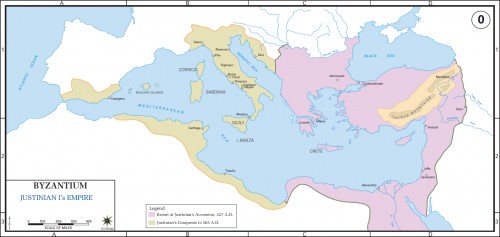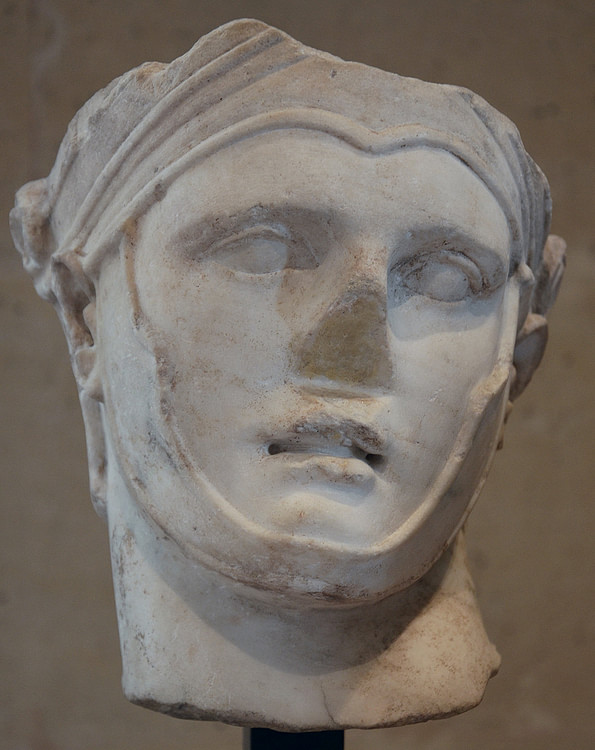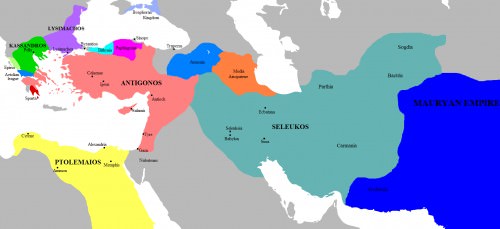Justinian I › Seleucus I Nicator » Ancient origins
Articles and Definitions › Contents
- Justinian I › Who Was
- Seleucus I Nicator › Who Was
Ancient civilizations › Historical and archaeological sites
Justinian I › Who Was
Definition and Origins
Justinian I reigned as emperor of the Byzantine Empire from 527 to 565 CE. Born around 482 CE in Tauresium, a village in Illyria, his uncle Emperor Justin I was an imperial bodyguard who reached the throne on the death of Anastasius in 518 CE.Justinian is considered one of the most important late Roman and Byzantine emperors. He started a significant military campaign to retake Africa from the Vandals (in 533 to 534 CE) and Italy from the Goths (535 to 554 CE). He also ordered the rebuilding of the Hagia Sophia church (begun in 532 CE) as well as an empire -wide construction drive, resulting in new churches, monasteries, forts, water reservoirs, and bridges. His other great achievement was the completion of the legal reforms encapsulated in the Corpus Juris Civilis between 529 and 534 CE. This was the bringing together of all the Roman laws that had been issued from the time of Emperor Hadrian (117 - 138 CE) to the present. He is widely held as one of the greatest (and most controversial) late Roman/Byzantine emperors in history.
JUSTINIAN'S EARLY LIFE
Not a great deal is known about Justinian's early life. His mother Vigilantia was the sister of the Excubitor (Imperial bodyguard). Justin adopted his nephew and brought him to Constantinople to guarantee his education. During Justin's reign, Justinian acted as a close confidant and advisor; he became Consul in 521 CE and thereafter commander of the Eastern army. In 525 CE he married Theodora, a woman from a poor background and possibly a courtesan.
THOUGH NOT AN ACTIVE SOLDIER HIMSELF, JUSTINIAN INITIATED AN ENORMOUS MILITARY ENTERPRISE WITH THE AIM OF TAKING ITALY, SICILY, AND AFRICA.
Though not an active soldier himself, Justinian initiated an enormous military enterprise with the aim of taking Italy, Sicily, and Africa. His military career began, however, in the east. The Iberian War (526 - 532 CE) was fought against the Sassanian Empire over control of the kingdom of Iberia in the Caucasus mountains (roughly the modern state of Georgia). The conflict was one theatre of a wider war against the Sassanian Empire going back to the time of Anastasius I. After several battles, a truce was signed upon the death of the Sassanian Shah (emperor) Kavadh I and the accession of his son Khosroes I.
JUSTINIAN & THE VANDALS
The Vandals had been in control of Africa's capital Carthage since 439 CE and thereafter spread their influence over Africa, Tripolitania, Corsica, Sardinia, and the Balearic islands. In 533 CE Justinian launched a reconquest effort aimed at claiming these areas for the Byzantine Empire. This began in the spring of 533 CE with an anti- Vandal revolt in Tripolitania (today's western Libya), which was consolidated by Roman soldiers from the empire's province of Cyrenaica. Soon after, General Belisarius (Justinian's most successful military leader) led a force of soldiers in ships from the Aegean, stopping off at Sicily and landing in Africa. A series of battles followed, and in the winter of 534 CE, the Vandal king Gelimer surrendered, leaving Africa in Roman hands after almost a century of Vandal rule.
THE GOTHIC WAR & TOTILA
The Goths had been in control of Italy and Sicily since 476 CE, when the last Roman Emperor in the West, Romulus Augustulus, was deposed. Though the Gothic Rex Italiae (King of Italy) Odoacer recognised the authority of the emperor in Constantinople, the Gothic regime began to initiate policies independent of the Roman sphere. The Roman aristocracy of Italy remained in a position of privilege even after the Gothic conquest, but conflict and disagreement emerged in 524 CE with the execution of the leading Roman Italian politician Boethius. In this context of discontent in the Gothic regime, Justinian sought to retake Italy and Sicily. The rapid conquest of Africa had encouraged the emperor, and he sent Belisarius with a small force to attack Sicily, which fell quickly to the Romans in 535 CE. By 540 CE, after a series of victories and defeats against the Goths and their allies in Italy as well as in Dalmatia (modern Croatia), Italy was secured for the Romans.

Empire of Justinian I
However, this was not the end of the Gothic War. Though much of Italy was under Roman control, some towns and cities(such as Verona ) remained under Gothic influence. Though soundly defeated, the remainder of the Gothic regime found a new leader in Totila. In the autumn of 541 CE, he was proclaimed king, soon after leading a reconquest of Italy. Though at the head of a relatively small force, Totila was helped in his goals by several problems in the Roman Empire. Around the same time, new hostilities opened between Justinian and the Sassanian Empire, which meant that resources had to be split between East and West. An outbreak of plague in 542 CE (later called the Justinianic Plague) crippled the empire's ability to respond.Totila thus managed to defeat the first Roman counter-attacks and captured Naples by siege in 543 CE. Rome itself changed hands three times in quick succession, ending up in 549 CE in the hands of Totila. Belisarius had attempted to defeat Totila on several occasions prior to this but was hampered by lack of supplies and support from Justinian. A new campaign was undertaken by Justinian's nephew Germanus Justinus, but he died in 551 CE, succeeded by the general Narses. In 553 CE, Narses defeated Totila and Italy was once again Roman.
Justinian's reign lasted almost 40 years, but it was not always popular. In 529 CE Julianus ben Sabar, a messianic figure in Palestine, led a revolt of the Samaritan people against the empire. In 532 CE Constantinople was gripped by civil discontent;the Nika riots lasted a week, resulted in the deaths of thousands of citizens, and left much of the monumental centre of the cityin ruins. A second Samaritan revolt in 559 CE, more significant and possibly involving elements of the Jewish population of Palestine, was not quelled until after the death of Justinian.
THE CODEX JUSTINIANUS
Early on in his reign, Justinian commissioned a legal expert in his court, Tribonian, to gather together numerous legal notes, commentaries, and laws of the Roman legal system into a single text which would hold the force of law: this was the Codex Iustinianus. In 529 CE the first edition was published, followed in 534 CE by a revised second edition (which unlike the first, survives today). The text is divided into titles relating to specific aspects of the law, and was composed in Latin. It contained laws on heresy, orthodoxy and paganism as well.
JUSTINIAN'S LIFE BY PROCOPIUS
Justinian is unique among Roman emperors in that his life was recorded in two separate sources by the same author.Procopius of Caesarea, who was a legal secretary to General Belisarius, composed De Bellis ("On the Wars [of Justinian]") between 545 and 553 CE, which records the successes and some failures of the military campaign the emperor launched. He also composed De Aedificiis ("On the buildings [of Justinian]") between 550 and 557 CE, a work describing in great detail the many building projects the emperor undertook during his reign. Procopius also composed the Anecdota (translated as "Secret History", less often as "Unpublished Things") between 550 and 562 CE that claims to reveal the reality of life in the imperial court. It details the alleged sexual activities of the Empress Theodora, the weak determination of the emperor, and the power that women held in the imperial court. Considering the very negative tone of the text, it is unclear if Procopius intended the work to portray a satirical take on life at court or a truer account of imperial life than is portrayed in the De Bellis or De Aedificiis. What is almost certain is that the Anecdota reveals that Procopius had lost faith in the regime of Justinian, in contrast to the positive feelings expressed in his earlier works.
Justinian is credited as one of the greatest emperors in late Roman and Byzantine history. His achievements in the fields of art, architecture, legal reform, and conquest are remarkable by the standards of any leader in history. The works of Procopius have contributed greatly to this understanding as well as criticisms of his regime. His Christian faith was evident in all the spheres of his enterprise, marking a step in the transition of emperors from leaders in war and politics to leaders of faith and patronage as well.
Seleucus I Nicator › Who Was
Definition and Origins

Despite not receiving his share of the fallen king's empire until several years later, Seleucus I Nicator ( Victor) was one of the more capable of the successors to the kingdom of Alexander the Great upon his death in 323 BCE. Seleucus and his descendants established what became known as the Seleucid Empire which lasted nearly 250 years.
EARLY LIFE OF SELEUCUS
As with the other successors to Alexander, Seleucus (358 – 281 BCE) was the son of a Macedonian nobleman, one of King Phillip II's generals. While little else of his family is known, historians do speak of a dream his mother had in which he was fathered not by Antiochus but by the Greek god Apollo. In the dream she received a unique ring inscribed with the symbol of an anchor. According to the legend, Seleucus was borne with the same anchor symbol in the form of a tattoo on his thigh. This oddity of birth led him to later lay claim to a divine kingship; however, some believe the entire story is a concoction, and he simply wished to emulate Alexander's similar claim to divinity. Even though his relationship to Alexander is not fully known (he may or may not have been a close companion), Seleucus followed the young Macedonian king's quest to conquer the Persian Empire and defeat Darius III.
The only certainty concerning his role in the Persian campaign is that he was one of the commanders of the hypaspists - the silver shields. This elect guard served as a buffer between the cavalry and infantry – a kind of elite police force. Each member of the hypaspists was carefully chosen on an individual basis not only for their social standing (there were regular and royal hypaspists ) but also for their physical strength and bravery. The hypaspists were known for their adept mobility and often used on special missions in rugged terrain as well as in situations that called for hand-to-hand combat.
LITTLE OF SELEUCUS' PRESENCE IS MENTIONED IN ANCIENT SOURCES UNTIL THE BATTLE OF HYDASPES AGAINST KING PORUS OF INDIA.
Little of Seleucus' presence is mentioned in ancient sources until the Battle of Hydaspes against King Porus of India. Prior to the battle, as Alexander and his forces crossed the Hydaspes River and prepared to meet the Indian king and his elephants, Alexander changed his normal defensive alignment. He stationed his archers (over 1,000) ahead of his Companion cavalry – this served as a screen against the elephants; they were followed by the infantry, the remaining cavalry, and lastly Seleucus and his hypaspists. Alexander's deployment was sound; he had wanted to avoid putting his cavalry directly against the elephants. Luckily for Alexander and his men, the elephants proved ineffective, actually doing more harm to the Indians than the Macedonians.
As Alexander had moved across Asia battling the Persians from Granicus through Issus and Gaugamela, he had hoped to unite the two worlds, spreading Hellenistic culture. Hydaspes, however, proved to be Alexander's last major conflict; he would and could go no further. After defeating King Porus in India, his men balked at going any further. Despite his plans, Alexander was forced to return to Babylon. While there he had to come to terms with rebellions, not only by the Persian provinces but also many of his own men. They resented the presence of Persians within the army and being forced to take Persian wives.(Only Seleucus kept his Persian wife, Apama). Alexander died before many of these problems could be resolved.
ALEXANDER'S DEATH
While Seleucus's name does not appear among those who chose to rebel against Alexander, it is mentioned just prior to the death of Alexander. The question arose among his generals– what to do with the body of the fallen king if he dies. The historian Plutarch in his The Life of Alexander mentions Seleucus only one time when he wrote: “It was also on this day that Python and Seleucus were sent to the sanctuary of Sarapis to ask if they should bring Alexander there, but the god told them to leave him where he was. And then he died late in the afternoon of the twenty-eight.”

Diadochi Satraps 323 BCE
With Alexander dead, the future of the empire lay in ruin. Who was to rule? Historians differ on what happened on that fateful day. Although most suggest Alexander was silent or unable to speak, some claim he didn't name any one specifically, only saying his successor was to be the strongest. One of his generals, Perdiccos, advised the others to delay a decision until the birth of Alexander's child (the future Alexander IV) by his wife, Roxanne. Ptolemy, choosing not to wait, led the fight to have the empire divided among the surviving generals. Perdiccos lost the argument and the empire was divided – the Wars of Diadochi or Wars of Successors began. The alliances that formed after the divide were tenuous at best, and the war would endure for another 50 years.
THE SUCCESSOR WARS
The reason for Ptolemy's desire to divide the empire was a selfish one, for he achieved a long time goal and acquired Egypt.While he proved to be a capable “ pharaoh,” one of his first acts was to kidnap the body of Alexander and bring him to Egypt.Perdiccos, who saw himself as the true successor to Alexander, had planned to ship the king's body to Macedonia where a tomb was being constructed; however, Ptolemy stole the body as it arrived in Damascus. This action led to an immediate and lengthy war between Peridiccos and Ptolemy. Although he served as an officer under Perdiccos and at first sided with him, Seleucus turned against him and aligned himself with Ptolemy. Some historians even believe he took part in Peridiccos' assassination. As a reward for his assistance, Seleucus was named governor of Babylon by Antipater.

Map of the Successor Kingdoms, c. 303 BCE
Because of jealousy and ambition among the other successors, Seleucus was unable to maintain his province's borders, and when Antigonos the One-Eyed invaded Babylon, Seleucus fled to Egypt in 316 BCE, seeking assistance and refuge from Ptolemy. In 312 BCE, and with the assistance of Ptolemy, Cassander and Lysimander, Seleucus was able to defeat Antigonos in the Battle of Gaza and regain his lost territory.
SELEUCUS' EMPIRE
Over the next few years, he assisted in the defeat and death of Antigonos at the Battle of Ipsus in 301 BCE, expanding his empire into Syria. Later, he captured the son of Antigonos, Demetrios, and held him prisoner until Demetrios' death in 285 BCE. Likewise, Seleucus proved himself to be a capable general and strategist in his own right; he expanded his own territory into Asia Minor and India, making peace and securing his southern border with the Indian ruler Chandraguta. He built the cities of Antioch (his new capital) and Seleucia located on the Tigris River. At the Battle of Corupedium, he defeated and killed Lysimachos, setting his eyes on Macedonia; however, he never succeeded in his conquest, dying in his attempt, killed by the son of his former ally, Ptolemy, who had wanted Macedonia for himself. Seleucus's memory would survive long after him, for his family established an empire that would live for generations to come.
LICENSE:
Article based on information obtained from these sources:with permission from the Website Ancient History Encyclopedia
Content is available under License Creative Commons: Attribution-NonCommercial-ShareAlike 3.0 Unported. CC-BY-NC-SA License